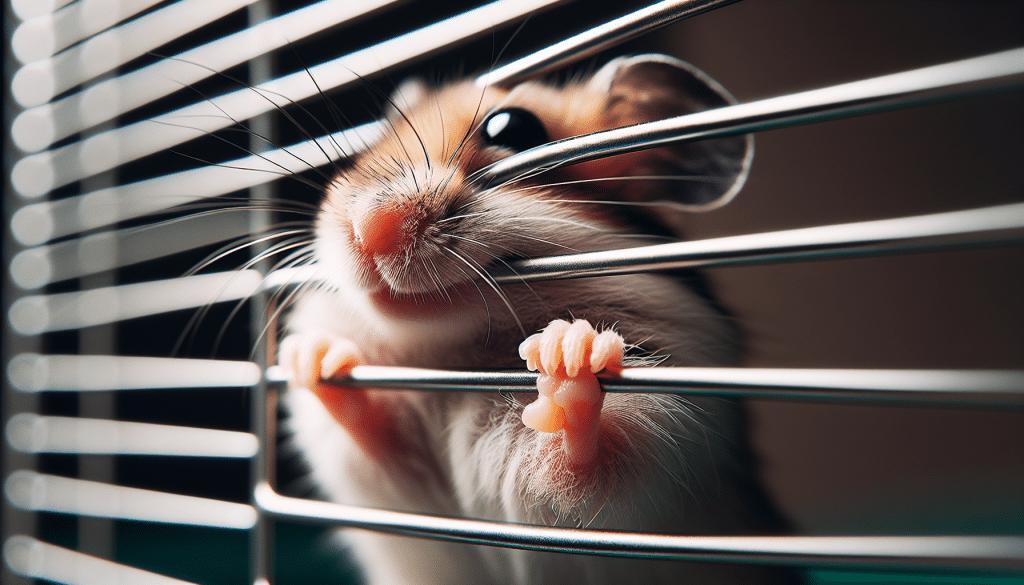So you’ve brought home a cute little hamster, but now you’re wondering why it seems to spend most of its time hiding or running on that never-ending wheel. In this article, we’ll shed some light on the fascinating world of hamster behavior. From their nocturnal nature to their cheek pouch obsession, you’ll gain a deeper understanding of why these furry creatures do what they do. Whether you’re a new hamster owner or simply curious about their captivating behavior, get ready to unlock the secrets of your furry friend’s actions.

Understanding the Basics of Hamster Behavior
As a responsible hamster owner, it’s important to have a solid understanding of your furry friend’s behavior. By familiarizing yourself with the typical activities and social dynamics of hamsters, you can ensure their overall well-being and better address their needs.
Defining Typical Hamster Activities
Hamsters are known for their energetic and curious nature. They engage in various activities such as running on exercise wheels, exploring tunnels and toys, and burrowing in bedding. Understanding these behaviors allows you to provide a suitable environment that promotes their natural instincts and keeps them physically and mentally stimulated.
The Importance of Understanding Your Hamster
Each hamster has its own unique personality and preferences. By observing and understanding your hamster’s behavior, you can determine what makes them happy or stressed. This knowledge helps you create an optimal living environment tailored to their specific needs, leading to a happy and healthy hamster.
Factors Affecting Hamster Behavior
Several factors influence hamster behavior. The environment, such as cage size, bedding type, and the availability of toys and hiding spots, can impact their activity levels and overall behavior. Additionally, the hamster’s age, breed, and past experiences may contribute to their behaviors. Being aware of these factors allows you to make necessary adjustments and modifications to provide the best care for your hamster.
Communication and Social Interaction
Hamsters communicate through a combination of vocalizations, body language, and gestures. Understanding these forms of communication is essential for interpreting your hamster’s needs and emotions and facilitating social interaction.
Interpreting Hamster Vocalizations
Hamsters produce a range of sounds, each with a distinct meaning. Some common vocalizations include squeaks, hisses, and chirps. Squeaks often indicate excitement or anxiety, whereas hisses may signal aggression or fear. Chirping sounds can be a sign of contentment. By paying attention to these vocalizations, you can better understand and respond to your hamster’s emotions.
Body Language and Gestures
Hamsters also rely on body language and gestures to communicate. For example, a hamster standing upright on its hind legs may be curious or on alert. On the other hand, a hamster hunching down with ears flattened against its head may be feeling threatened. Additionally, grooming behaviors, such as excessive scratching or licking, can indicate discomfort or illness. By observing your hamster’s body language, you can gauge their mood and well-being.
Social Dynamics Among Hamsters
Hamsters are generally solitary animals and prefer to live alone. However, it’s important to note that some breeds, like Dwarf hamsters, may tolerate same-sex cage mates when introduced properly. It’s crucial to monitor their interactions closely to prevent aggression and provide enough space and resources for each hamster. Understanding social dynamics is necessary to ensure a harmonious and stress-free living environment for your hamsters.

Feeding and Foraging Behaviors
Understanding your hamster’s feeding and foraging behaviors is essential for their overall health and well-being. Providing a proper diet and addressing their natural instincts can help prevent hunger and malnutrition.
Common Eating Habits
Hamsters are omnivorous and enjoy a diverse diet. They primarily consume commercial hamster food, which is a balanced mix of grains, seeds, and pellets. Additionally, hamsters benefit from occasional fresh fruits, vegetables, and protein-rich sources such as meat or insects. Ensure a variety of foods are available to fulfill their nutritional needs and encourage foraging behaviors.
Hoarding and Storing Food
One interesting behavior of hamsters is their natural instinct to hoard and store food. Hamsters have cheek pouches that they use to transport and store food for later consumption. It’s important to provide ample bedding material for them to create their own food stores, satisfying their innate foraging behavior.
Identifying Signs of Hunger or Malnutrition
Monitoring your hamster’s eating habits is crucial in identifying signs of hunger or malnutrition. If you notice a decrease in food consumption or weight loss, it could be an indication of health issues or a dietary problem. Consult a veterinarian if you suspect your hamster is not eating properly or exhibits any signs of malnutrition.
Sleeping Patterns and Nesting
Understanding the sleeping patterns and preferences of hamsters allows you to provide a suitable and comfortable environment for them to rest and feel secure.
Understanding the Nocturnal Nature of Hamsters
Hamsters are nocturnal animals, meaning they are most active during the night. They sleep during the day and become more active in the evening and throughout the night. This behavior is essential for their survival in the wild and should be respected when keeping them as pets.
Ideal Sleeping Environments
Hamsters require a quiet, dark, and cozy sleeping environment to feel safe and secure. Providing a well-insulated and comfortable nest area helps mimic their natural burrows and promotes proper sleep. Avoid disturbing your hamster during their sleep cycle to prevent unnecessary stress.
Nesting Materials and Preferences
Hamsters enjoy creating nests using suitable materials. Provide them with safe bedding choices, such as paper-based or aspen shavings, to allow them to build their nests. Avoid using cedar or pine bedding, as it can be harmful to their respiratory system. Ensuring a consistent supply of fresh bedding material lets your hamster exhibit their nesting behaviors.

Exercise and Play
Hamsters require regular exercise to stay physically active and maintain their overall health. Providing opportunities for exercise and play is vital for their well-being.
The Importance of Exercise Wheels
Exercise wheels are essential for fulfilling your hamster’s need for physical activity. This allows them to run and expend their energy in a safe and controlled environment. Choose a solid and appropriately-sized wheel to prevent injury and provide your hamster with a suitable outlet for exercise.
Providing Diverse Play Options
In addition to exercise wheels, offer a variety of toys and enrichment activities to keep your hamster engaged and entertained. This may include tunnels, chew toys, puzzle feeders, and climbing structures. Rotating toys and providing new ones occasionally prevents boredom and encourages exploration.
Monitoring Activity Levels
Observing your hamster’s activity levels and ensuring they have ample time outside their cage for free-roaming and exploration is important. Regular interaction and playtime helps maintain their physical and mental well-being. Monitor your hamster’s weight and energy levels to ensure they are getting enough exercise.
Grooming and Self-Care
Hamsters are naturally clean animals and spend a significant amount of time grooming themselves. Understanding their grooming behaviors and addressing any grooming issues ensures their hygiene and well-being.
Normal Grooming Behaviors
Hamsters groom themselves regularly by licking their fur, face, and paws. They use their paws and teeth to clean and groom hard-to-reach areas. This behavior helps them maintain a healthy coat and remove any dirt or parasites. Regular grooming is a positive sign of a healthy hamster.
When Grooming Indicates a Problem
Excessive grooming or changes in grooming patterns can be an indication of health issues or stress. If you notice your hamster excessively scratching, losing fur, or exhibiting any signs of discomfort, it’s important to seek veterinary care and address the underlying cause.
How to Assist with Hamster Hygiene
While hamsters are proficient at grooming themselves, occasionally they may need some assistance. In some cases, long-haired hamster breeds may require gentle brushing to prevent matting or tangling. However, it’s important to use a soft-bristle brush designed specifically for small animals and be cautious to avoid causing any harm or discomfort to your hamster.
Hamster Training and Taming
Training and taming your hamster not only enhances your bond with them but also helps create a harmonious living environment. With patience and positive reinforcement, you can teach your hamster various commands and tricks.
Basic Training Techniques
Start by establishing trust and building a positive association with your hamster through offering treats and gentle handling. Once your hamster is comfortable with your presence, you can introduce basic training techniques, such as teaching them to come to you or use a designated potty area. Training should be conducted in short sessions using rewards and praises to encourage desired behaviors.
Building Trust with Your Hamster
Building trust is crucial for successful training. Spend time with your hamster daily, providing treats, gentle interactions, and a calm environment. Avoid sudden movements or loud noises that can startle your hamster. Slowly and gradually increase the level of interaction and handling to strengthen the bond of trust between you and your furry friend.
Teaching Commands and Tricks
Once your hamster has established trust, you can introduce basic commands and tricks. This could include teaching them to spin in a circle, jump over a low obstacle, or retrieve a small item. Patience, repetition, and positive reinforcement are key elements in teaching your hamster new skills. Always keep the training sessions short and enjoyable for your hamster.
Handling and Bonding with Your Hamster
Proper handling techniques are essential for the well-being of your hamster. Establishing a bond and trust through gentle handling allows for positive interactions and reduces stress for both you and your pet.
Approaching and Picking Up Your Hamster Safely
Approaching and picking up your hamster should be done cautiously to prevent injury or escape. Gently place your hand in the cage and allow your hamster to approach you. When picking them up, use cupped hands or a tunnel to create a safe and secure environment. Support their entire body to prevent any accidental falls or injuries.
Recognizing Signs of Stress During Handling
Hamsters can exhibit signs of stress or discomfort during handling. This may include rapid breathing, attempts to escape, biting, or freezing in place. It’s important to respect your hamster’s boundaries and avoid forcing them into situations that cause stress. Understanding their body language and responding accordingly helps foster a positive and trusting relationship.
Strengthening Your Bond Over Time
Building a strong bond with your hamster takes time and patience. Regular interactions, gentle handling, and providing a safe and enriching environment contribute to a positive bond. Each hamster is unique, so it’s important to respect their preferences and personality traits. With time and understanding, your hamster will grow to trust and enjoy your companionship.
Territorial Behaviors and Aggression
Hamsters are naturally territorial animals and may exhibit aggressive behavior when their territory is threatened. Understanding and addressing territorial behaviors allows you to create a peaceful living environment and prevent unnecessary conflicts.
Identifying Territorial Marking
Territorial marking is a common behavior displayed by hamsters. They may urinate or deposit scent glands around their cage to mark their territory. This behavior helps them establish boundaries and communicate with other hamsters. Regular cage cleaning and maintaining proper hygiene are essential to prevent excessive marking.
Dealing with Hamster Aggression
Aggression among hamsters may occur when introducing new cage mates or in certain territorial disputes. It’s important to be cautious and avoid situations that may trigger aggressive behavior. Providing separate living spaces and supervised socialization allows for safer interactions and reduces the risk of harm.
How to Introduce Hamsters to One Another
If you wish to have multiple hamsters, proper introduction techniques are crucial. Begin by keeping the hamsters in separate cages within close proximity, allowing them to become familiar with each other’s scents. Gradually introduce them in a neutral territory under close supervision, observing their behavior for signs of aggression. If aggression persists, it may be necessary to keep them in separate living spaces to prevent harm.
The Effect of Aging on Hamster Behavior
As hamsters age, their behavior and needs may change. It’s important to adapt their care accordingly and be aware of the signs of declining health.
Behavioral Differences in Young vs. Older Hamsters
Young hamsters are typically more active and curious, while older hamsters may exhibit a decrease in activity levels and become more reserved. It’s important to monitor any changes in behavior, appetite, or mobility as they age. Providing appropriate care, diet, and veterinary attention assists in ensuring the well-being of senior hamsters.
Adapting Care for Senior Hamsters
Senior hamsters may require modifications to their environment and care routine. Ensuring easy access to food, water, and bedding is crucial for hamsters with mobility issues. Providing softer bedding materials and additional sources of warmth helps them stay comfortable. Regular veterinary check-ups are essential to address any age-related health concerns.
Recognizing the Signs of Declining Health
As hamsters age, they may experience age-related health issues. It’s important to recognize the signs of declining health, such as weight loss, changes in appetite or drinking habits, difficulty breathing, or lethargy. Regular observation and prompt veterinary care are vital to detect and address any potential health problems early on.
By understanding the basics of hamster behavior and implementing appropriate care and interaction strategies, you can ensure the happiness and well-being of your furry friend. Remember, each hamster is unique, so observing and tailoring your approach to their individual needs is key to building a strong and rewarding relationship.



